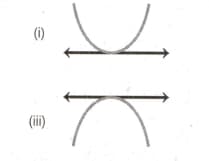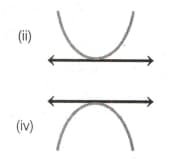In a set of quadratic equations, the discriminant D for different equations is such that . Then which one of the following is not true?

Important Questions on Theory of Equations
Which one(s) of the following graphs is/are correctly sketched for the given quadratic equation which has a double root (i.e., both the roots are equal), considering that all of these graphs appear considerably thick when seen with a magnifying lens? The horizontal lines, in these graphs, represent the X-axis.


The graph of the equation is shown below. If D denotes the discriminant of this equation; S and P, denote the sum and product of the roots of this equation, respectively. Then which of the following facts is/are true pertaining to this graph?

Some facts are given below for a quadratic equation , and then four graphs are also drawn. If D denotes the discriminant of this equation; S and P denote the sum and product of the roots of this equation, respectively, which one of the following graphs is the best representative of all these facts?
